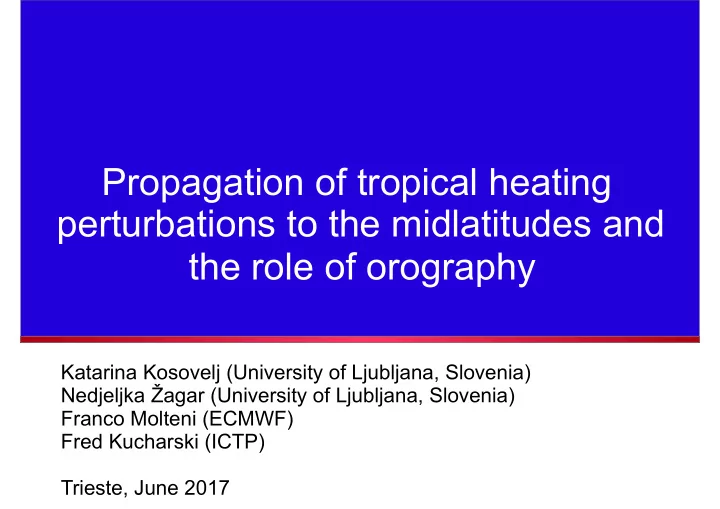

Propagation of tropical heating perturbations to the midlatitudes and the role of orography Katarina Kosovelj (University of Ljubljana, Slovenia) Nedjeljka Ž agar (University of Ljubljana, Slovenia) Franco Molteni (ECMWF) Fred Kucharski (ICTP) Trieste, June 2017
Outline l Motivation l Methodology l Short-term response to tropical heating l Medium-term response to tropical heating l The role of orography l Summary
Motivation Tropical processes strongly influence midlatitude weather processes in the medium-range and longer forecasts At the same time, analysis uncertainties and short-range forecast errors are largest in the tropics. They are shown to be associated with both balanced and unbalanced circulation across all spatial scales. Little is known about the impact of the tropical analysis uncertainties on the growth of forecast errors in the mid- latitudes. Perturbations in diabatic heating in the tropics have long-term impact on forecasts of the midlatitude circulation. We aim to quantify the role of unbalanced component of the large-scale circulation response to these perturbations in the tropics and their propagation outside the tropics.
Experiment set-up The model: ICTP AGCM (SPEEDY), version 41, T30 (Molteni 2003, Clim Dyn; l Kucharski et al. 2006, Clim Dyn) Experiment set-up: l Continuous unperturbed control run for 32 years - Every 1 st January from the third year on, the model was restarted with continuous additional - heating perturbation, and run for 3 months. 30 ensemble members in northern hemisphere winter. Year 1 Year 2 Year 3 Year 4 Year 5 control ensemble members Heating perturbation in one ensemble member at 500 hPa, averaged over 90 days [K/day] Heating perturbation from Molteni and Kucharski. - Daily means were analyzed with MODES decomposition. -
MODES decomposition Physical space ( x,y,z,t ) Modal space ( k,n,m,t ) Circulation is split in balanced and unbalanced components defined in terms of l eigensolutions of the linearized primitive equations. The balanced part consists of the Rossby (quasi-geostrophic) waves. The unbalanced l part projects onto the inertio-gravity eigensolutions that propagate eastward (EIG modes) or westward (WIG modes). Inertio-gravity modes → unbalanced modes (UBAL) l http://meteo.fmf.uni-lj.si/MODES
MODES decomposition h"p://meteo.fmf.uni-‑lj.si/MODES ¡
MODES decomposition Geopotential height Total perturbation (m) in color & wind vectors (m/s) Unbalanced part Balanced part
MODES decomposition Balanced part n=1 n=2 n=3
MODES decomposition Unbalanced part remaining Kelvin mode unbalanced modes
Short-term response Short-term response → mostly confined to tropics l Medium-term response → Rossby wave train in midlatitudes l total BAL UBAL Beginning of the Rossby wave train Kelvin wave? Rossby n=1?
Medium-term response Short-term response → confined to tropics l Medium-term response → Rossby wave train in midlatitudes l Rossby wave trains
Kelvin and Rossby n=1 modes
The role of orography 3 additional experiments, the only difference was that part of the northern l hemisphere orography was lowered to maximum 100 m. Himalayas and Tibet (no HT) - Rocky Mountains and Greenland (no RG) - Himalayas, Tibet, Rocky Mountains and Greenland (no HTRG) - The question: what is dynamic effect of orography on growth and propagation l of perturbations. No HT No RG No HTRG In midlatitudes the intensity and propagation of Rossby wave train are l affected by the large-scale orography.
The role of orography Balanced part, day 14 J/kg J/kg Ref. no HTRG J/kg J/kg no RG no HT
Summary A novel method for the decomposition of 3D global circulation to the balanced l and unbalanced components, MODES, has been applied to diagnose the global response to tropical heating perturbation In the tropics, the balanced and unbalanced components of the response have l comparable amplitudes. Circulation response in tropics is confined close to the heating source (possibly l due to the dipole structure of the heating) The midlatitudinal response consist of the (balanced) Rossby wave train. l Removal of orography increases the variability in odd (symmetric) Rossby l modes. The largest variability appears in Rossby n=3, at zonal wavenumber 4.
The role of orography Hovmöller diagrams at 50 °N Midlatitudes → BAL part
Recommend
More recommend